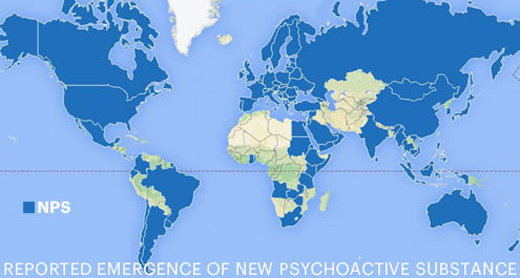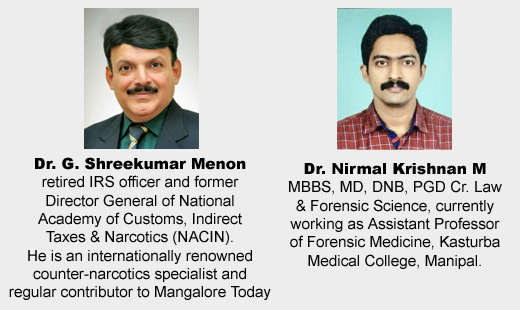Forensic Testing of Narcotic Drugs – X: Unanticipated Challenge of NPS to Forensic Science
Forensic Testing of Narcotic Drugs – X: Unanticipated Challenge of NPS to Forensic Science
Mangalore Today News Network
By Dr. G. Shreekumar Menon, IRS (Rtd), Ph.D. (Narcotics) & Dr. Nirmal Krishnan, MBBS, MD (Forensic Science)
Mangaluru, September 1, 2022: New Psychoactive Substances (NPS) are substances of abuse, either in a pure form or a preparation, that are not controlled by the 1961 Single Convention on Narcotic Drugs or the 1971 Convention on Psychotropic Substances, but which pose a public health threat. In this context, the term ‘new’ does not necessarily refer to new inventions but to substances that have become recently available in the market.

New psychoactive substances (NPS) have rapidly emerged in global markets purportedly as “legal” alternatives to internationally controlled drugs, causing similar effects to the latter, but with the potential to pose serious threats to public health and safety. The fast-paced nature of this market, the increased availability of these cheap substances and the reports of increased consumption and trade in such substances have drawn concerns among the international community as there is the potential for transnational organized criminal groups to exploit the market for these substances.
NPS has been known in the market by terms such as ‘designer drugs’, ‘legal highs’, ‘herbal highs’, ‘bath salts’. The term ‘designer drugs’ had been traditionally used to identify synthetic substances but has recently been broadened to include other psychoactive substances that mimic the effects of illicit drugs and are produced by introducing slight modifications to the chemical structure of controlled substances to circumvent drug controls. ‘Legal highs’, ‘herbal highs’, ‘research chemicals’ and ‘bath salts’ are also alternative names used to refer to NPS,assured as a legal alternative to controlled drugs. These substances are often labelled as ‘not for human consumption’.
Many of the substances that are available in the market for NPS contain unfamiliar molecules that may or may not share similar risk effects and profiles to the illicit substances they are designed to mimic. As a result, they may pose serious challenges to researchers and policy-makers that try to assess the risk of harm and to take suitable measures to control them. Research on most NPS is very limited. There are no comprehensive scientific studies on their toxicity and most studies are based on work in animals, fatal poisonings in humans or clinical observations in intoxicated patients. Toxicity, abuse liability and risks associated with long-term use in particular remain unknown. Most NPS have little or no history of medical use.  New psychoactive substances (NPS) are growing at an alarming rate causing a threat to the public health. They are available online or in shops and come with variety of street names across cities, states, and countries. NPS are prepared in the laboratories either by tweaking or altering the chemical structure of existing substances such as Cannabis and Ecstasy. They are cheap, easy to obtain, and difficult to be detected by traditional drug screening methods. It has become very challenging to detect them within the clinical settings because of their constant changing structure. Their purity as well as pharmacology and toxic effects are still not well known. These drugs cause major life-threatening complications. The legal status of these drugs is ambiguous. The laws are complex, and not explicitly defined to control or regulate their use which is a serious drawback.
New psychoactive substances (NPS) are growing at an alarming rate causing a threat to the public health. They are available online or in shops and come with variety of street names across cities, states, and countries. NPS are prepared in the laboratories either by tweaking or altering the chemical structure of existing substances such as Cannabis and Ecstasy. They are cheap, easy to obtain, and difficult to be detected by traditional drug screening methods. It has become very challenging to detect them within the clinical settings because of their constant changing structure. Their purity as well as pharmacology and toxic effects are still not well known. These drugs cause major life-threatening complications. The legal status of these drugs is ambiguous. The laws are complex, and not explicitly defined to control or regulate their use which is a serious drawback.
NPS are sold in different forms such as powders, pills, smoking mixtures, liquids, capsules, plant extracts, or plant cuttings. They are cheap, easily available, and cannot be detected by routine screenings.
In recent years, the number and diversity of NPS with potentially serious risks to public health has continued to increase. The first comprehensive United Nations Office on Drugs and Crime (UNODC) report on NPS, titled ‘The Challenge of New Psychoactive Substances’, provided for the first time global data on the emergence of these substances, presently over 451 substances have been identified.
The UNODC has classified NPS into six categories: sedatives/hypnotics; Dissociatives; Hallucinogens; Stimulants; Synthetic Cannabinoid Receptor Agonists and Opioids.
Only a few countries report the emergence of most of the NPS encountered worldwide. A number of countries that have not reported the emergence of NPS officially may indeed have these substances in their markets. The failure to report is often attributed in part to the inability of their forensic laboratories to identify such substances, and to the absence of a legislative framework that supports legal seizures of NPS.

In 2013, the United Nations Office of Drugs & Crimes (UNODC) established an Early Warning Advisory (EWA) to monitor the emergence of NPS, analyze the market trends associated with these substances, tailor support to drug analysis laboratories and support the formulation of effective measures to mitigate this problem at the global level.This report is the first global situation assessment on new psychoactive substances put forward under the Global SMART Programme and pursuant to Commission on Narcotic Drugs Resolution 55/1 on “Promoting international cooperation in responding to the challenges posed by new psychoactive substances”, which requested the United Nations Office on Drugs and Crime to provide an update to its 2011 report entitled “Synthetic cannabinoids in herbal products”, addressing a wider range of new psychoactive substances, in addition to synthetic cannabinoids, and to take into consideration the creation of a compilation of new psychoactive substances encountered by Member States, to serve as an early warning advisory.
The complex challenges presented by the emergence of NPS to the forensic science community include: the sheer number and diversity of substances flooding the markets; the geographical heterogeneity of the emergence of these substances; the transient and rapidly changing nature of some substances in the drug markets; and the evolution of sequences of closely related substances which are often manufactured to circumvent legal controls.
While techniques and methods for the identification and analysis of traditional substances of abuse such as heroin and cocaine are readily available, the forensic community faces a grave challenge in analyzing and identifying NPS.
Forensic science practice in general, is globally plagued by a number of issues, such as the unending backlog of cases, inadequate infrastructure of laboratories in many countries; lack of a research culture; financial and human resource capacities.
Another aspect is difficulties in acquiring NPS reference standards, and in determining which reference materials are required to enable the identification of unknown NPS.
The number and diversity of NPS continue to increase, and there are no signs of this slowing down in the immediate future. Legislative measures put in place by some governments, such as generic measures of control, have meant that the discipline of analysis of drugs faces an exponential growth in the number of controlled substances and a dilemma in even defining which substances are controlled. Notwithstanding the challenges faced by forensic science with regard to NPS, it still has a key role to play in improving our understanding of this emerging phenomenon and in assessing the effectiveness of legislative interventions at both the national and international levels.
Many of the substances that are available in the market and sold as NPS contain unfamiliar molecules that may or may not share similar risk effects and profiles to the illicit substances they are designed to mimic. As a result, they may pose serious challenges to researchers and policy-makers that try to assess the risk of harm and to take suitable measures to control them. Research on most NPS is very limited. There are no comprehensive scientific studies on their toxicity and most studies are based on work in animals, fatal poisonings in humans or clinical observations in intoxicated patients. Toxicity, abuse liability and risks associated with long-term use in particular remain unknown. Most NPS have little or no history of medical use.
Many clinicians have limited exposure to NPS. When patients report with acute withdrawal syndrome or complications like overdose, the clinicians are not able to identify which NPS has caused them and hence quick treatment becomes difficult. Some hospital settings do not have the sophisticated analytical technology available for identifying NPS, especially when new drugs first appear on the market. The structure of NPS keeps changing rapidly that these substances cannot be detected in urine with routine screening methods. Toxicology laboratories play a crucial role in the assessment of identifying acute harms that might be associated with NPS use.

NPSs are not novel to Indian market, although the data is limited. There are several media reports about the seizure of a particular NPS known as Meow Meow or Mephedrone in many cities in India. This drug has gained tremendous popularity among Indian teenagers as it is a lot cheaper than cocaine. Mephedrone, manufactured in India and China, is marketed as plant feed or bath salts on the internet.These drugs have caught the fancy of the new affluent young generation of India and is used as a cheap party drug. Initially, the drug was not in the list of banned drugs in India but was included in the list in March 2015. The first nationwide survey indicated new emerging trend of substance use in India with amphetamine-like substances (ATS) beingpopular in specific regions like Goa and Ahmedabad. Another very popular party drug is Ecstasy used extensively in Kerala and Goa. There is lack of awareness about the pharmacology and toxic effects of these drugs among the health professionals in India.
NPS pose a serious public health crisis. There is sudden explosive emergence of these substances which has caused an epidemic of toxic exposures.
Unfortunately, this area is still poorly investigated, and very limited information is available so far of their nature and potential risks. The health professionals should maintain a high degree of alertness for NPS use and their possible psychological effects among vulnerable people. The phenomenon of NPS requires multidisciplinary research in areas of epidemiology, pharmacology, and prevention. Research-guided prevention education would help in tackling this global health problem. The societal and political sensitization on this issue is the need of the hour.
Writers can be contacted at: shreemenon48@gmail.com and drnirmalknambiar@gmail.com

- Rethinking Drug Seizure Coverage: A Call for Health-Centred Narratives
- Substance abuse - A pressing concern among medical students
- China is winning the trade war without fighting
- Poll promises can become political nightmares
- While India sticks to death by hanging other execution methods vary across the world
- Spiking of drinks, a grave threat for students’ security
- Burden of drugs and substance use among university students in India
- Mangalore medic’s miracle in Bombay 1957
- Needed a national protocol for treatment of substance use disorders
- The Lingering Menace of Drug Abuse Among the Indian Youth—It’s Time for Action
- Need For ‘Students, Alcohol and Drugs’ survey
- New Synthetic Drugs Trapping Youth
- Mood Modifying Chips - Future of Drug Use
- Kashmir Bhavan in Bengaluru: A must visit place
- "MAI and I" Book of Angelic Emotions
- Draupadi Murmu - The New ’President of India’
- Anthony Ashram in the city grows a classic museum
- First College of Fisheries in India - A Golden Jubilarian
- Flushing Meadows - A Vintage Mansion
- The Colonel’s Bequest
- A Mangalorean PM and his RBI Governor Brother: The Extraordinary story of the Benegal Brothers
- There is no higher religion than Truth: Theosophical Society
- L’affaire - Ashu & Yiju of Mangalore
- Mangalore in Kowloon
- 1568 to 2018 AD: 450 years of Christianity in Mangaluru
- Vice President elect Naidu moves on from nadir to zenith, the phenomenal journey
- Embracing the Outdoors: How Heated Jackets Are Revolutionizing Cold Weather Activities
- Efficient and Sustainable Packaging Solutions with FIBCs
- The Hybrid Kilt Revolution | Where Tradition Gets Trendy
- Affordable Elegance | Embrace Style on a Budget with Cheap Kilts
- Unleashing Style and Functionality | Exploring Tactical Kilts
- Mangalore’s Heroic Lady marks 105th Birthday
- Santa the Christmas spirit
- Geriatric care: Mangalore strikes a fine balance
- The Don Who Made Two Empires to Clash
- CHITRAPUR SARASWATS - A Great Kanara Community
- Our new President Ram Nath Kovind’s significant journey to Rashtrapathi Bhavan
- Marriages made in heaven, big fat weddings made in India
- Eid insight - The giver of glad tidings
- CITY INFORMATION
- TRAVEL
- TOURIST INFORMATION
- HEALTH CARE
- MISCELLANEOUS




 Write Comment
Write Comment E-Mail To a Friend
E-Mail To a Friend Facebook
Facebook Twitter
Twitter  Print
Print 

